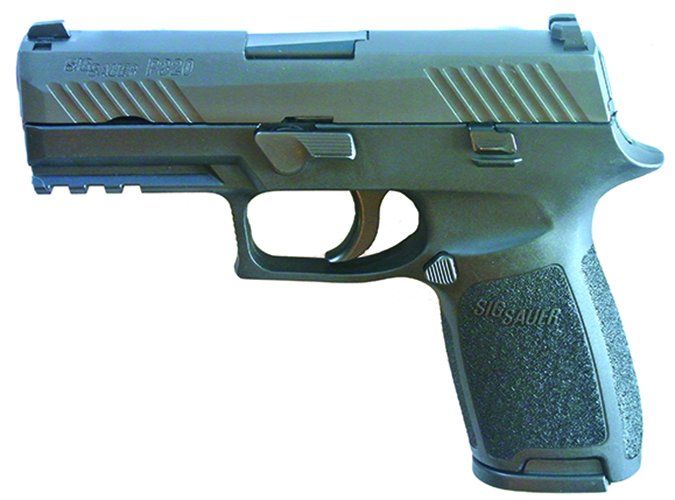
As noted earlier in this issue, 9mm auto-loading pistols are among the most commonly purchased firearms in America for pleasure, competition, and defense. These guns are offered in many styles and price points, ranging from a few hundred to several thousands of dollars. While the handguns in this comparison are not top-end, highly customized pistols costing thousands of dollars, they are generally marketed as being well above average quality in fit, features, and capabilities.
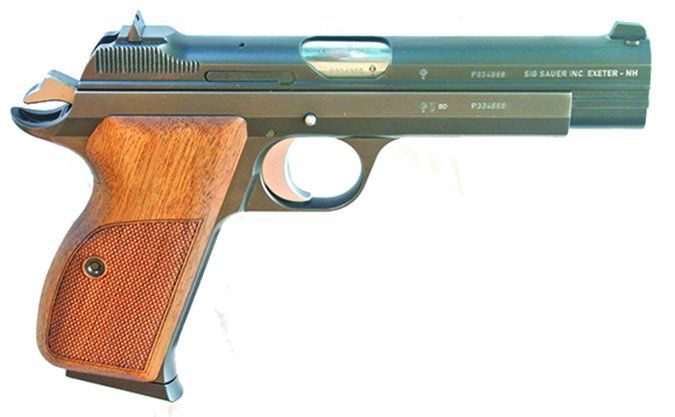
In this comparison, we test five pistols, three of which were built by SIG Sauer, one by Beretta, and one newcomer from Arsenal. The SIGs tested are the classic P210, the P226 MK25 used by the U.S. Navy SEALS, and the relatively new P320. The Beretta tested is the recently updated M9A3. The fifth gun is the new Strike One from Arsenal.
For our evaluation, we used three different 9mm loads from three different manufacturers in two different weights and two different bullet styles. As always, the guns in question were shot by multiple testers (this time three men and three women) of different backgrounds.
9x19mm Luger Range Data
| Federal 115-gr. JHP | SIG Sauer P320 Carry | SIG Sauer P226 MK-25 | SIG Sauer P210 Legend | Beretta M9A3 | Arsenal Firearms AF1-Strike One AWP |
| Smallest group | 2.3 in. | 3.6 in. | 1.3 in. | 2.9 in. | 1.9 in. |
| Largest group | 3.2 in. | 4.8 in. | 5.1 in. | 5.6 in. | 4.3 in. |
| Average group | 2.8 in. | 4.4 in. | 3.6 in. | 4.1 in. | 3.2 in. |
| Sellier & Bellot 124-gr. FMJ | |||||
| Smallest group | 1.9 in. | 2.9 in. | 2.7 in. | 2.6 in. | 3.3 in. |
| Largest group | 5.4 in. | 7.4 in. | 5.5 in. | 6.4 in. | 4.6 in. |
| Average group | 3.6 in. | 5 in. | 3.7 in. | 5.2 in. | 3.9 in. |
| RWS 124-gr. FMJ | |||||
| Smallest group | 1 in. | 2.4 in. | 2.7 in. | 2.3 in. | 2.7 in. |
| Largest group | 5 in. | 4.6 in. | 5.3 in. | 7.6 in. | 4.2 in. |
| Average group | 3.2 in. | 3.4 in. | 4.6 in. | 4.9 in. | 3.6 in. |
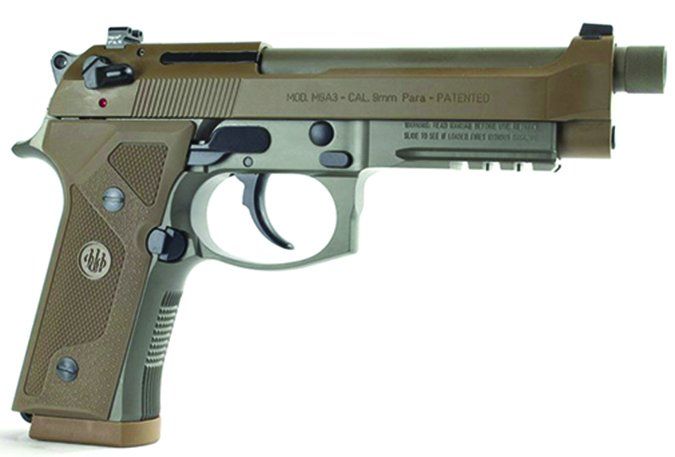
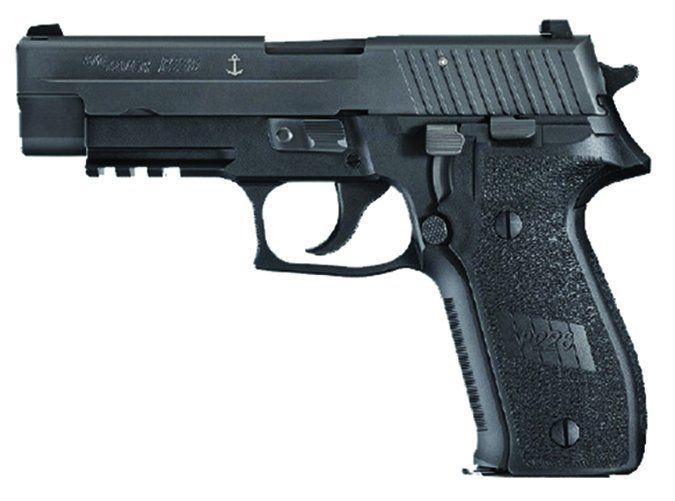
We did our accuracy testing at Boyert Shooting Centers, an indoor range in Houston, and followed the standard accuracy protocol of collecting five 5-round groups at 25 yards from a rest for each pistol/ammunition combination. For this test, we also performed a speed drill. The speed drill involved starting from a low-ready position, shooting twice to the chest and once to the head of a silhouette paper target. This test was performed at 7 yards by one experienced tester with large hands. The speed test was performed after the familiarization shooting, but before the accuracy testing. The tester was given only one opportunity to perform the test. As these pistols are supposed to be superior to the average offering, our team expected above-average results and graded accordingly. Though all five pistols turned in good results and had their fans, the testing yielded one clear surprise winner.
Arsenal Firearms AF1 Strike One AWP 9mm Luger, $750
GUN TESTS GRADE: B
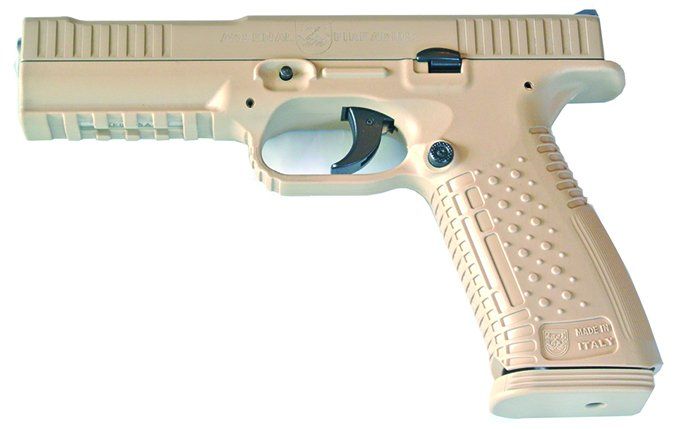
The Strike One is effective tool for those it fit. But we graded it down a notch because of flaws in the finish. The reduced muzzle flip is an advantage.
| ACTION | Semi-auto DAO Striker, short recoil |
| OVERALL LENGTH | 8.3 in. |
| OVERALL HEIGHT | 5.6 in. |
| MAX WIDTH | 1.3 in. |
| WEIGHT UNLOADED | 26.5 oz. |
| BARREL | 5 in., FDE steel; target crown Bergmann-style low-profile |
| MAGAZINES | (2) 17-rd. |
| MAGAZINE RELEASE | Round button, left, reversible |
| SLIDE | FDE steel, ambidextrous release |
| FRAME | Polymer, FDE Cerakote w/ rail |
| GRIP | FDE checkered polymer |
| FRONT SIGHT | 1 dot post |
| REAR SIGHT | 2 dot |
| TRIGGER WEIGHT | 5.7 lbs. |
| TRIGGER SPAN | 2.7 in. |
| SIGHT RADIUS | 7.3 in. |
| SAFETY | None |
| WARRANTY | 1 year limited |
| WEBSITE | ArsenalInc.com |
| TELEPHONE | (702) 643-2220 |
| MADE IN | Italy |
| CALIFORNIA COMPLIANT | No |
| MASSACHUSETTS COMPLIANT | No |
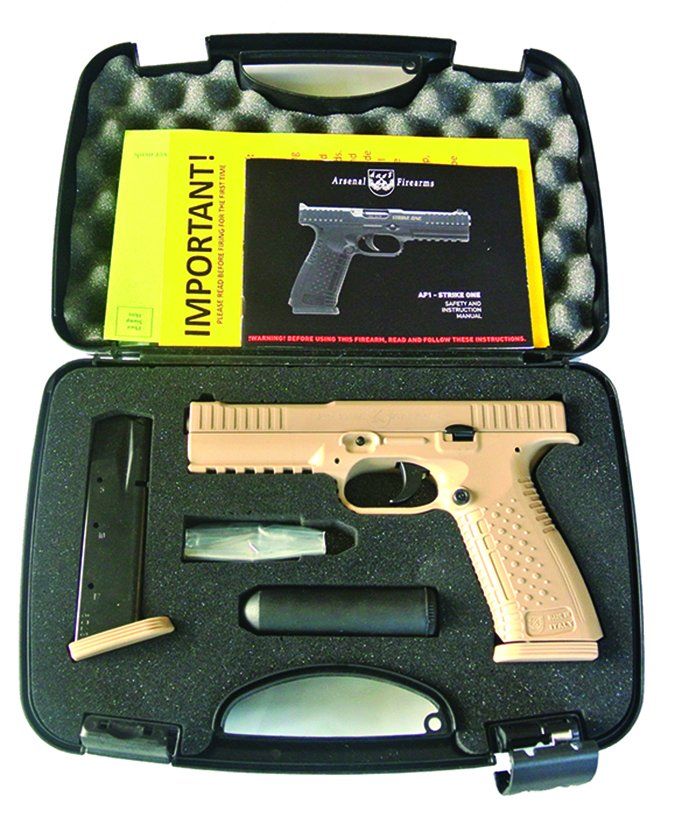
The Arsenal Strike One is a polymer-frame short-recoil-operated striker-fired semi-automatic pistol introduced by Arsenal Firearms of Italy in 2012. The Strike One is a little different than the standard Browning short-recoil-operated pistol in that it uses the Bergman operating mechanism first developed for the Bergman-Bayard pistol in 1903. This results in a lower bore axis relative to the firing hand. The frame also has unusually long rails. While the testers didn’t notice a difference in felt recoil, several noted that muzzle flip was noticeably reduced. This effect was particularly noticeable by non-shooting observers when watching the shooter alternate between the Strike One and the other pistols.

This design difference also means the cleaning procedure is slightly different from the norm. This process is well described in the manual and requires no tools. In summary, one ensures the pistol is clear of ammo and then pulls the trigger. While holding the slide and frame in your dominant hand, push the takedown pin out with the non-dominant finger, then pull the captive pin out with the nail of the thumb. Push the slide assembly forward and off the frame. Now remove the recoil spring assembly, locking block, and barrel. The pistol is now fully field-stripped for cleaning. The pistol comes in a locking hard case with two magazines and a cleaning kit.
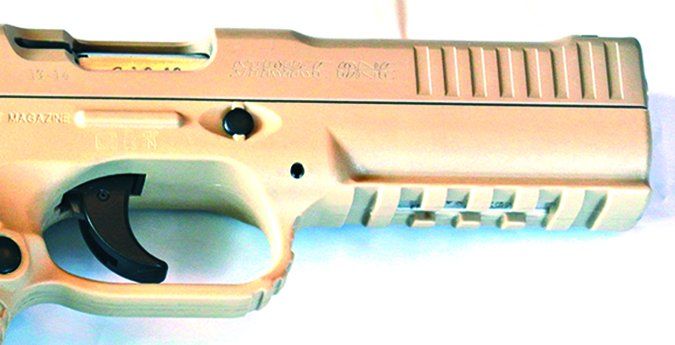
Our sample was the full-sized AWP (All Weather Pistol) model with a flat-dark-earth Cerakote coating. The coating was not consistent in color, had a couple of marred areas, and had a tendency to fill in some of the engraved areas. The testers had varied opinions on the looks of the gun. Some thought it looked very modernistic, and others thought it looked “insectoid” or like a toy. As beauty is in the eye of the beholder, we trust our faithful readers will decide for themselves whether to favor the looks, or not.

Despite having the second-longest barrel at 5 inches and a middle-of-the-pack overall length of 8.3 inches, the pistol was second lightest at 26.5 ounces, with a slight muzzle-heavy bias. The slide-to-frame fit was very tight and smooth.
The Strike One has a Picatinny rail and a very effective magazine funnel. The magazines were a little sticky for one tester in the beginning, but quickly broke in and gave no further issues. The protective ridge interfered with one tester’s ability to quickly use the magazine release, but none of the other testers complained. The long and skinny grip size, shape, and texture was not universally liked by the testing team. The Strike One does not have interchangeable backstraps, as is becoming common in more recent designs.

The striker showed a white dot when cocked, and the trigger was slightly better than industry average, with a straight-back pull averaging 5.7 pounds with a little overtravel. The trigger had more grit during take up than we liked, and the trigger reset was difficult to detect. The testers agreed that the trigger was okay, but not outstanding, for a pistol that’s supposed to be better than average.
The three-dot sights were not tritium, and one tester did not like the rear triangular sight. The sights did prove to be effective during the accuracy tests. The Strike One was accurate, with groups under 4 inches at 25 yards from a rest with all three loads. The Federal 115-grain hollow points grouped the best at 3.2 inches, with a best of 1.9 inches. The RWS followed at 3.6 inches, with the best group at 2.7 inches. The Sellier & Bellot trailed at a consistent 3.9 inches. The pistol placed third in the speed drills with an elapsed time of 3.53 seconds. There were no failures to function.
Our Team Said: While the test team found this pistol to be unconventional, they all agreed that the Strike One was an effective tool for those it fit. However, the flaws in the finish resulted in an overall “B” grade. Buy the Arsenal if it fits you and you like to play speed games where the reduced muzzle flip is an advantage. Otherwise, we would recommend buying a different gun in this test.
Beretta M9A3 JS92M A3M 9mm Luger, $1099
GUN TESTS GRADE: B
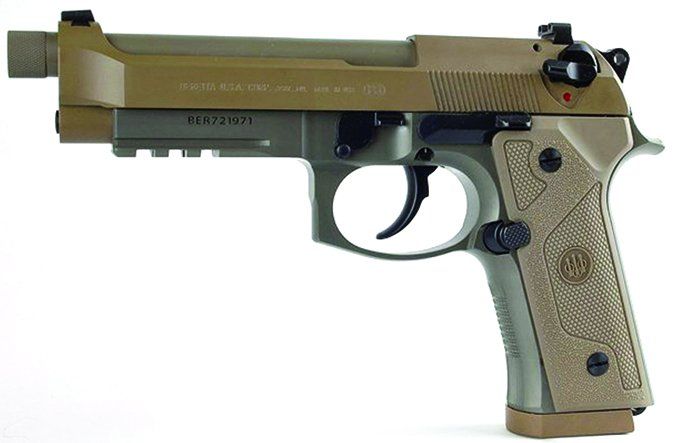
The Beretta worked well for shooters with larger hands and it was fast in the speed drills. However, it wasn’t that accurate, and shooters with smaller hands didn’t like it.
| ACTION | DA/SA short recoil semi |
| OVERALL LENGTH | 8.7 in. |
| OVERALL HEIGHT | 5.4 in. |
| MAX WIDTH | 1.5 in. |
| WEIGHT UNLOADED | 33.3 oz. |
| BARREL | 5.1 in., 1:9.8 RH, 6 grooves, FDE steel; threaded crown; tilting lock |
| MAGAZINES | (3) 17-rd. |
| MAGAZINE RELEASE | Round button, reversible |
| SLIDE | Steel, FDE Cerakote over Bruniton; left release |
| FRAME | Anodized aluminum w/ rail |
| GRIP | FDE checkered polymer |
| FRONT SIGHT | 1 dot tritium post |
| REAR SIGHT | 2 dot tritium |
| TRIGGER WEIGHT DA | 10.3 lbs. |
| TRIGGER WEIGHT SA | 5.6 lbs. |
| TRIGGER SPAN | 2.7 in. |
| SIGHT RADIUS | 6.3 in. |
| SAFETY | Slide mounted, ambidextrous |
| WARRANTY | 1 year + 2 years w/ registration |
| WEBSITE | Beretta.com |
| TELEPHONE | (800) BERETTA |
| MADE IN | USA |
| CA COMPLIANT | No |
| MA COMPLIANT | No |
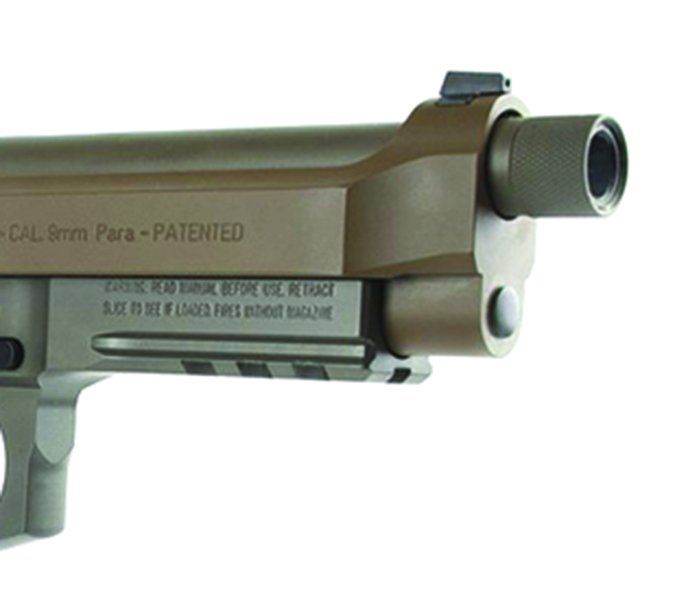
The Beretta M9 has been the U.S. Army standard sidearm since 1985. The M9A3 was a Beretta initiative to provide the U.S. Army with an improved version based on 30+ years field experience at no additional cost. The U.S. Army declined Beretta’s offer for a variety of officially stated reasons. Therefore, Beretta has made the pistol available to civilians. While the design and operation is very familiar to many shooters, some of the obvious differences to the standard M9 include a flat dark earth finish, three-slot Picatinny rail, thinner stock with two removable wraparound grips, replaceable sights, reshaped 17-round magazines, and a threaded barrel. Our example came in a very impressive ammobox-style container that contained the pistol, three magazines, lock, and spare grip, all secured in foam cutouts.
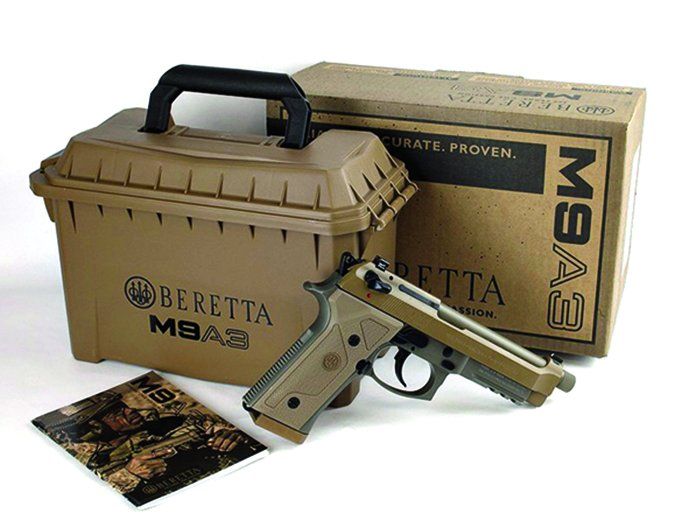
The M9A3 showed no play between the slide and frame. It had an evenly applied finish with two distinct shades of flat dark earth on the slide and frame. The sights were sturdy and bright Trijicon night sights that could be drifted for windage. The trigger was the standard double-action type with a better-than-average pull. The double-action stroke had a very smooth, but long, movement averaging 10.3 pounds with a little overtravel. The single-action stroke also had a lot of take up, but released cleanly at an average of 5.6 pounds.
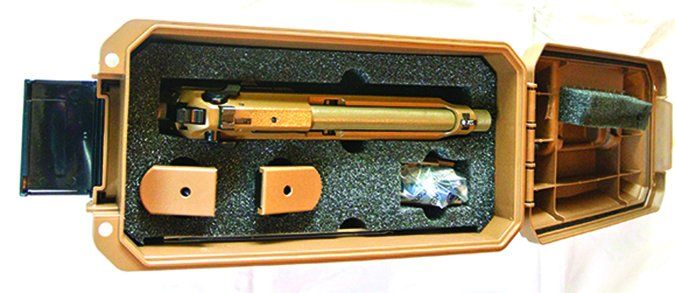
The test team’s opinions fell into two distinct groups when it came to using the controls. Those with larger hands found the Beretta’s controls very easy to use. Those testers with smaller hands found the pistol very difficult to manipulate.
The Beretta’s accuracy was tested in single-action mode and trailed the rest of the pistols in this comparison. The M9A3 performed best with the Federal hollow points at a 4.1-inch average and a best group of 2.9 inches. The RWS ammo shot an average of 4.9 inches, with the smallest group being 2.3 inches. This particular Beretta did not like the Sellier & Bellot ammo, with an average of 5.2 inches and only one group less than 5 inches. However, even shooting the first shot double action, the Beretta placed first in the speed drills with an elapsed time of 3.13 seconds.
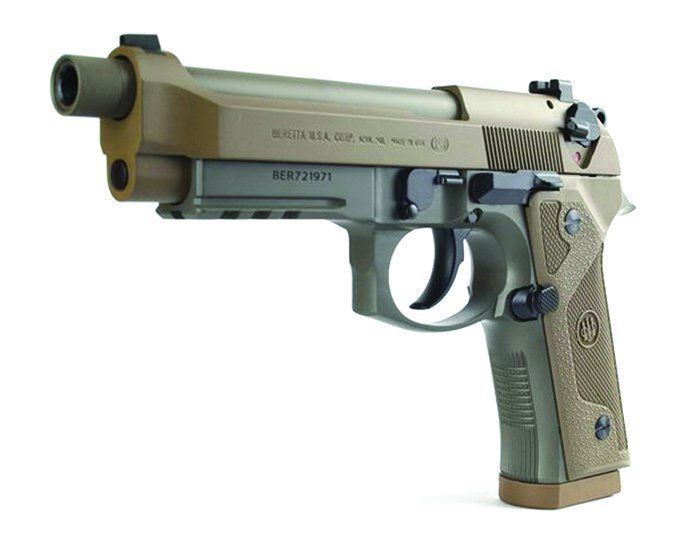
Our Team Said: While the test team was divided on the usability of this pistol, the Beretta worked well for shooters with larger hands. The Beretta performed best in the speed drills. However, the average accuracy and incompatibility with smaller hands resulted in an overall “B” grade. Buy the Beretta if it fits you and you want an upgraded example of the standard U.S. military sidearm to add to your collection. Otherwise, we would recommend buying a different gun in this test.
SIG Sauer P210 Legend 210-9-Legend 9x19mm Luger, $2000
GUN TESTS GRADE: B
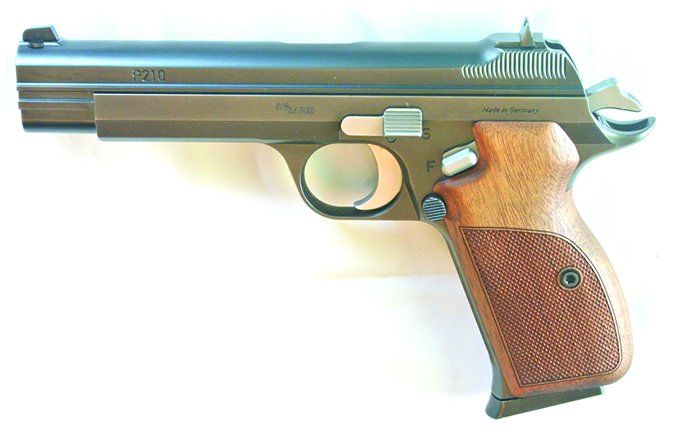
Most found the P210 to be the nicest-looking and most finely built pistol in the test. However, you will have to pay a premium for its old-world craftsmanship.
| ACTION | Semi-auto single action short recoil |
| OVERALL LENGTH | 8.5 in. |
| OVERALL HEIGHT | 5.6 in. |
| MAX WIDTH | 1.3 in. |
| WEIGHT UNLOADED | 37.4 oz. |
| BARREL | 4.7 in., 1:9.8 RH, 6 grooves, steel; round crown |
| MAGAZINES | (2) 8-rd. |
| MAGAZINE RELEASE | Round button, left side |
| SLIDE | Black Nitron carbon steel |
| FRAME | Black Nitron carbon steel |
| GRIP | Checkered wood |
| FRONT SIGHT | Post, windage adjustable |
| REAR SIGHT | Steel notch |
| TRIGGER WEIGHT SA | 4.25 lbs. |
| TRIGGER SPAN | 2.7 in. |
| SIGHT RADIUS | 6.3 in. |
| SAFETY | Frame mounted |
| WARRANTY | NA |
| WEBSITE | SIGSauer.com |
| TELEPHONE | (603) 610-3000 |
| MADE IN | Germany |
| CA COMPLIANT | No |
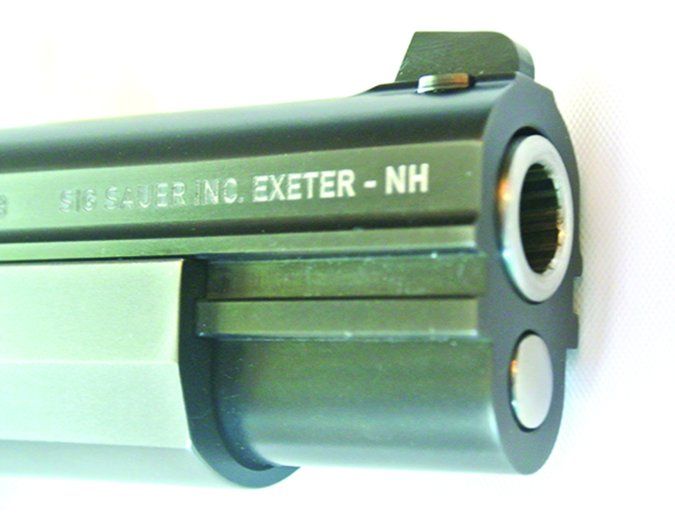
Our next pistol is the first of the three SIGs in our comparison. The P210 Legend is aptly named. This classic design, which has its origins in the Charles Petter 1935 pistol, was the official sidearm for Swiss army and police units from 1949 through 1975. It has been available in the U.S. as recently as 2014, but at this time is not included in the SIG catalog. Therefore our sample was a used gun. The P210 harkens to a prior era when guns were made of steel and wood. Many of the testers remarked on the very high quality of workmanship and solid feel of the pistol. For example, the two halves of the wood stock were so closely fitted that the seam could not be seen. Several of the testers felt the P210 was the most attractive pistol tested. Of course this quality has a cost and the SIG P210 was the most expensive gun in our test. Made of forged carbon steel, the P210 had an even Nitron coating and extremely crisp lines and engravings. The slide moved very smoothly. Even our tester with the smallest and weakest hands found the slide easy to rack. An interesting design feature is that the slide of the P210 rides inside of the pistol’s frame. This gives increased bearing surface between frame and slide, and by some accounts, may be a contributor to accuracy. The P210 is highly respected by sport shooters due to its reputation for accuracy and the pistol’s quality, weight, and feel.
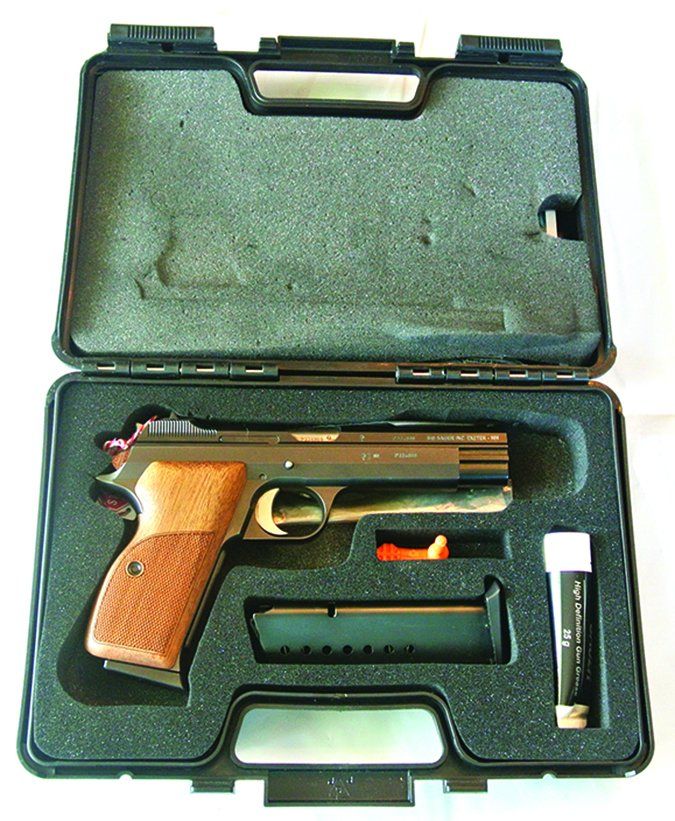
While the heaviest gun of the test at 37.4 ounces unloaded, the single-stack 8-round magazines made for the slimmest grip in the test. The testers who complained about the girth of the Beretta praised the relatively svelte P210. On the other hand, the testers who preferred the double-stack magazines of the other four pistols thought the P210 grip, while usable, was a little small. We also encountered issues with the stock screw repeatedly coming loose. This was concerning since spare parts could be expensive and hard to come by. However, it could be easily resolved with some thread-locking compound.
While all the testers found the safety easy to move to the Fire position, most of the testers found it more difficult to move it back up to the Safe position. The slide and magazine releases were difficult to work for testers with smaller hands. The entire team thought the trigger was excellent, with little take-up and almost no overtravel. The crisp 4.25-pound weight almost always resulted in a surprise break.
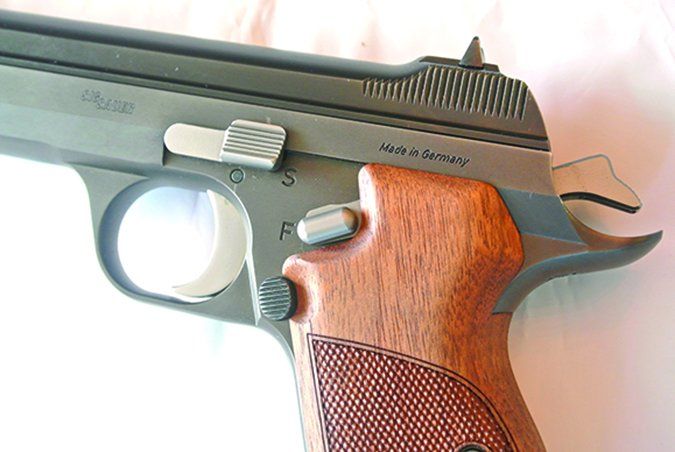
The team was less enthusiastic about the sights. The very plain sights riding above the 4.7-inch barrel were all black with no dots. They were clearly set up for daylight precision more than low-light speed. In fact, the P210 came in last in the speed drills with an elapsed time of 4.32 seconds. The sights showed up extremely well on lighter backgrounds but could be difficult to resolve in low light or against darker backgrounds. The sights clearly impacted the accuracy results when we tested in the subdued lighting of the indoor range.
Once again, the Federal hollow points performed best with an average of 3.6 inches and a best group of 1.3 inches at 25 yards. The Sellier & Bellot came in second with an average of 3.6 inches with a best of 2.7. The RWS rounded out the test with an average of 4.6 inches with a best of 2.7 inches. Based on our outdoor familiarization shoots, we strongly believe the accuracy results would have been better in brighter light.
Our Team Said: The majority of the test team found the P210 to be the nicest looking and most finely built pistol in the test. However, the dated ergonomics of the design showed its age, resulting in a “B” grade. Buy the SIG P210 Legend if it fits you and you don’t mind paying a premium for old-world craftsmanship. Otherwise, we would recommend buying a different gun in this test.
SIG Sauer P226 MK-25 9x19mm Luger, $1000
GUN TESTS GRADE: B
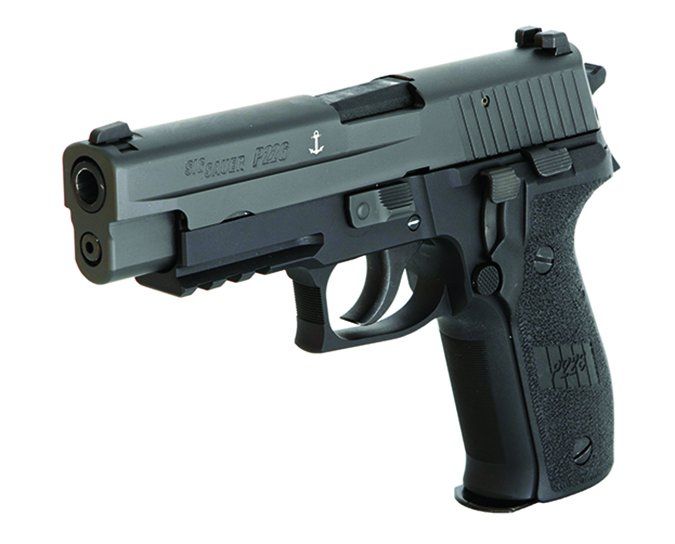
The majority of the test team found the P226 MK25 to be a professional-grade tool. However, the less-than-stellar accuracy was a surprise. Our shooters expected more.
| ACTION | Semi-auto DA/SA short recoil |
| OVERALL LENGTH | 7.7 in. |
| OVERALL HEIGHT | 5.5 in. |
| MAX WIDTH | 1.5 in. |
| WEIGHT UNLOADED | 34.4 oz. |
| BARREL | 4.4 in.; 1:9.8 RH, 6 grooves, Nitron-coated steel; round crown |
| MAGAZINES | (3) 15-rd. |
| MAGAZINE RELEASE | Round button, left side, reversible |
| SLIDE | Black Nitron stainless steel |
| FRAME | Black Nitron anodized aluminum |
| GRIP | Wraparound black polymer |
| FRONT SIGHT | 1 dot tritium post, windage adjustable |
| REAR SIGHT | 2 dot tritium |
| TRIGGER SPAN DA | 12 lbs. |
| TRIGGER SPAN SA | 5.4 lbs. |
| TRIGGER SPAN | 3 in. |
| SIGHT RADIUS | 6.3 in. |
| SAFETY | Frame mounted |
| WARRANTY | Limited lifetime |
| WEBSITE | SIGSauer.com |
| TELEPHONE | (603) 610-3000 |
| MADE IN | USA |
| CA COMPLIANT | No |
| MA COMPLIANT | No |
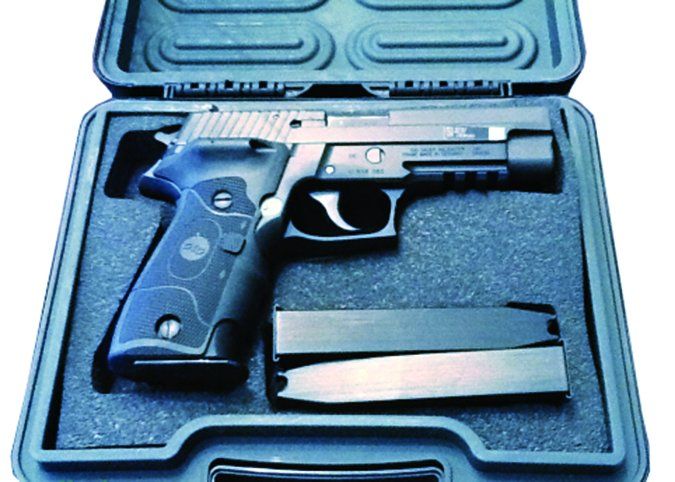
Which brings us to the next gun in our test, the SIG Sauer P226 MK25. Generally based on the design of the second generation P220, the P226 MK25 is a flat black, double-action 9mm that is claimed to be identical the pistols issued to the U.S. Navy SEALs. The P226 and the Beretta were the only two pistols to pass the U.S. Army XM9 pistol trials in 1984. According to a GAO report, Beretta won due to a lower total package cost. The P228, a compact version of the P226, was later designated the M11 and issued to investigative military police services and to troopers with very small hands. Many law-enforcement units use the P226 or one of its many variants as their standard duty sidearm. The P226 uses a modified Browning locked-breech, short-recoil-operating system with the barrel and slide locking together using an enlarged breech section and ejection port. This simple and strong action has been adopted by many manufacturers since its introduction.
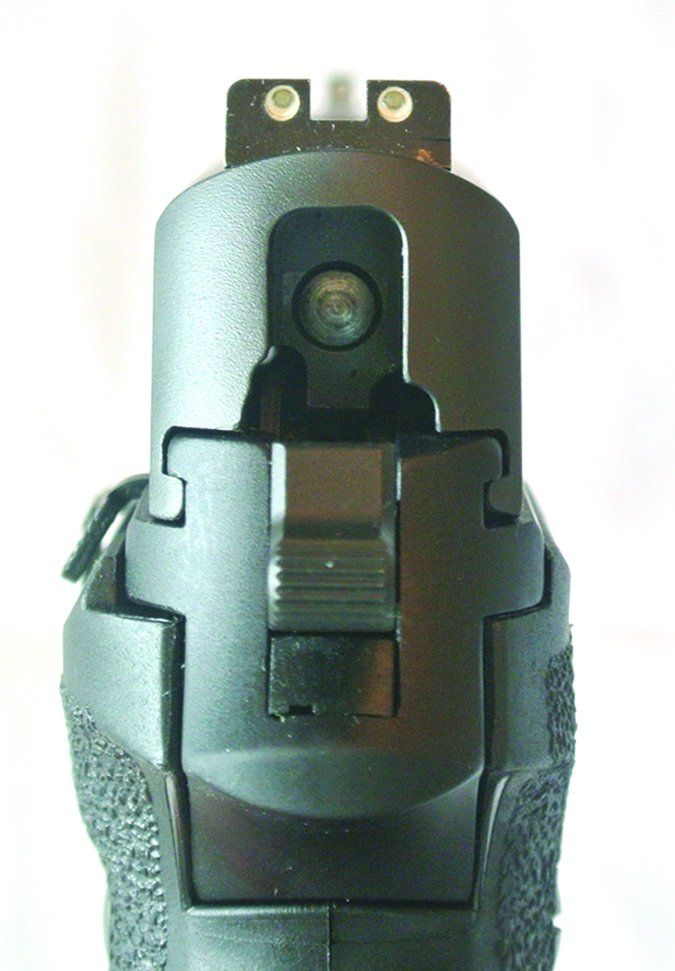
The pistol field strips easily for cleaning using the take down lever on the left side of the frame. All other controls are also on the left side of the pistol and include the magazine release, slide release and a decocker lever. The right side of the pistol is slick with no controls to catch on clothing. The magazine release is reversible.
The P226 MK differs from the standard P226 in that it is marked with a silver anchor and UID panel on the left side, has a mil-spec accessory rail, and uses the black Nitron (nitride) anti-corrosion coatings on all controls and exterior and interior surfaces. Our example came with three dot Sig-Lite tritium night sights and three double-column magazines holding 15 rounds each contained in the standard SIG Sauer plastic gun case. While the MK25 was the second shortest pistol at 7.7 inches, it was second heaviest at 34.4 ounces.
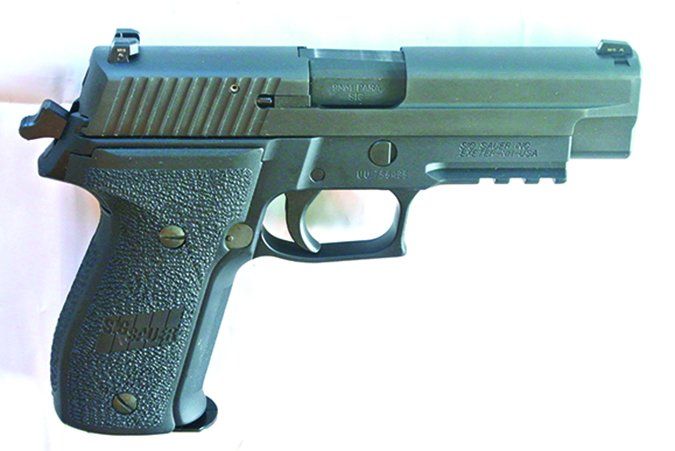
The trigger is of the classic double action/single action variety. It was very smooth and predictable with a 12 pound break in double action and a 5 pound, 6 ounce single action pull. The trigger exhibited some over travel and had a fairly long but easily discernible reset. The decocker worked easily but one of the testers did not like its location. When the team first started testing the MK25, we experienced a couple of failures for the slide to lock. Since this issue quickly disappeared, it is likely that the pistol just needed to be broken in. Most testers thought the pistol and its controls were easy to work, though one tester with smaller hands noted that the magazine release is too far away and the slide release difficult to activate. This same tester could not fire the pistol in double action but found the pistol to be a natural pointer despite small hands. All testers found the slide to be the easiest to manipulate in the test. The wrap-around plastic grips were universally well received. All the testers also liked the three dot tritium night sites. While there was some play between the slide and frame, all the testers thought that the pistol gave an overall impression of good quality.
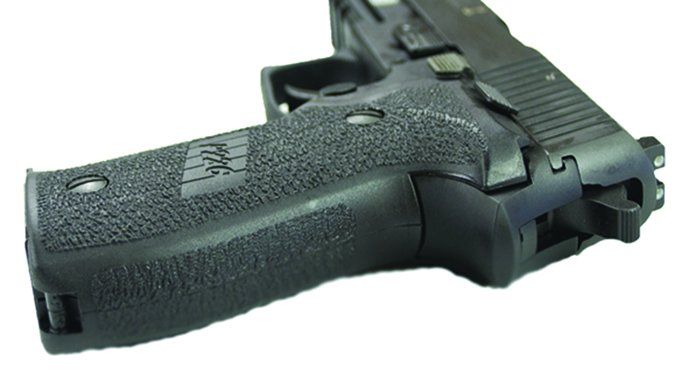
The pistol was pleasant to shoot but did not group as well as expected. The first round of most groups consistently shot high and left for all shooters. The sights were easy to use in all lighting conditions. The MK25 was the only pistol that didn’t shoot best with the Federal JHP, shooting an average of 4.4 inches with a small of 3.6 and a max of 4.8. The Sellier and Bellot was inconsistent in this example averaging 5.0 inches with a small group of 2.9 and a large group of 7.4 inches. This MK25 did like the RWS ammunition showing a respectable average of 3.4 inches with the smallest group being 2.4 inches and the largest being 3.4 inches. Nonetheless, the 25 yard group averages would likely meet the design purposes of this pistol. This pistol came in fourth in the speed drills with an elapsed time of 4.24 seconds. However, almost half that time was due to the initial double action trigger pull. Cock the hammer back and this pistol is very fast in action.
Our Team Said: The majority of the test team found the P226 MK25 to be a well built, professional grade tool that should withstand anything short of outright and intentional abuse. However, the less-than-stellar accuracy resulted in a “B” grade. Buy the SIG P226 MK25 if it fits you and you don’t mind paying a small premium to own the same pistol as the SEALs.
SIG Sauer P320 Carry 320CA-9-BSS 9mm Luger, $550
GUN TESTS GRADE: A
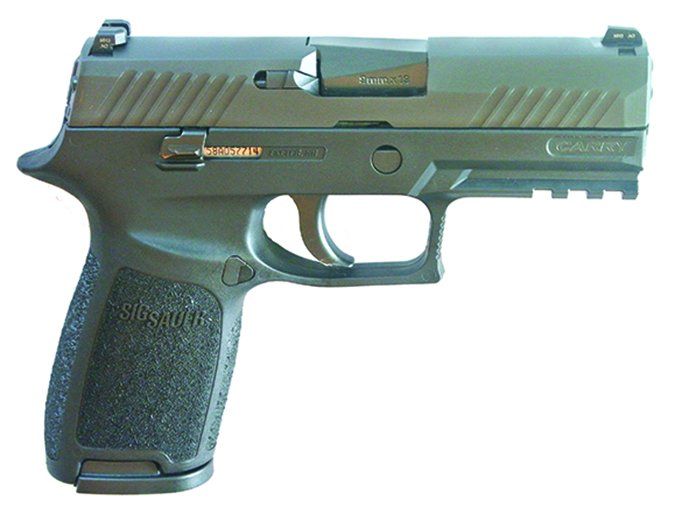
The least expensive pistol proved to be the most accurate, most flexible, and most ergonomic design in this test. With the options available, there is very little this pistol can not do.
| ACTION | Semi-auto DAO striker, short recoil |
| OVERALL LENGTH | 7.2 in. |
| OVERALL HEIGHT | 5.5 in. |
| MAX WIDTH | 1.4 in. |
| WEIGHT UNLOADED | 26 oz. |
| BARREL | 3.9 in. long; 1:9.8 RH twist, 6 grooves, black finish, round crown |
| MAGAZINES | (2) 17-rd. |
| MAGAZINE RELEASE | Triangular button, left slide, reversible |
| SLIDE | Nitron finish stainless steel, ambidextrous release |
| FRAME | Black polymer w/ rail |
| GRIP | Interchangeable black polymer |
| FRONT SIGHT | SIGLight Night Sight, 1 dot tritium post |
| REAR SIGHT | SIGLight Night Sight, 2 dot tritium, windage adjustable |
| TRIGGER WEIGHT | 8.1 lbs. |
| TRIGGER SPAN | 2.8 in. |
| SIGHT RADIUS | 5.8 in. |
| SAFETY | Striker, disconnect |
| WARRANTY | Limited lifetime |
| WEBSITE | SIGSauer.com |
| TELEPHONE | (603) 610-3000 |
| CA COMPLIANT | No |
| MA COMPLIANT | No |
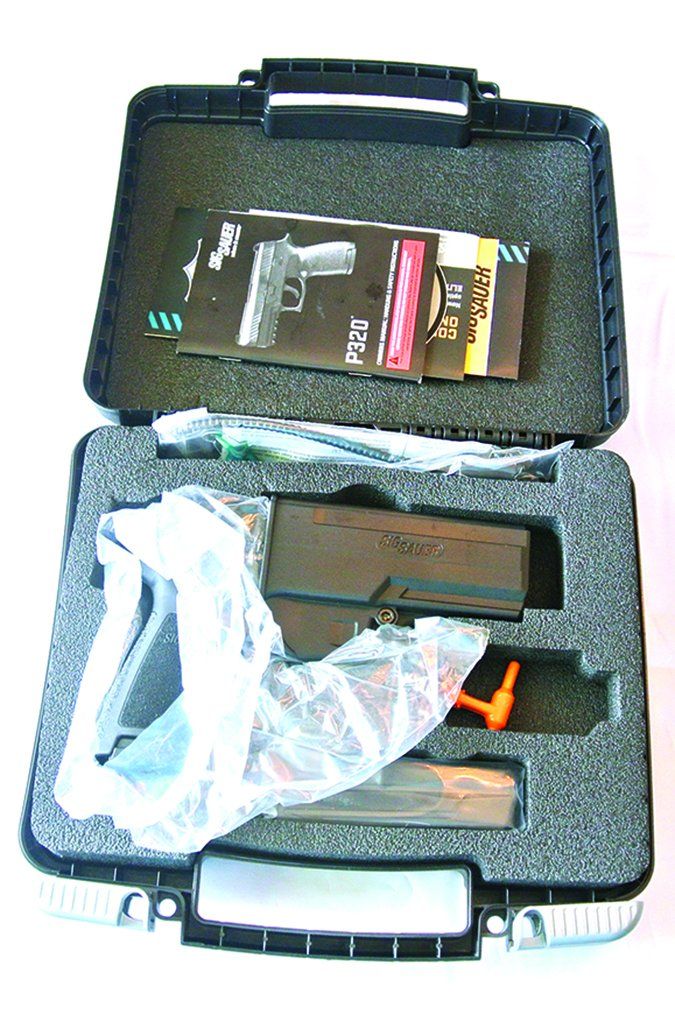
The P320 is also built by SIG Sauer. Our specific example is the mid-size P320CA Carry edition. A striker-fired black-polymer-framed 9mm, the P320 is the latest generation of pistol introduced by SIG Sauer in 2014. The P320 uses the same lockup system as the P226 MK25. What makes the P320 unique is its modular design. The core of the pistol is its stainless-steel receiver module, which contains the fire-control group, ejector, ambidextrous slide release, and four slide rails. It is this receiver that is marked with the serial number.
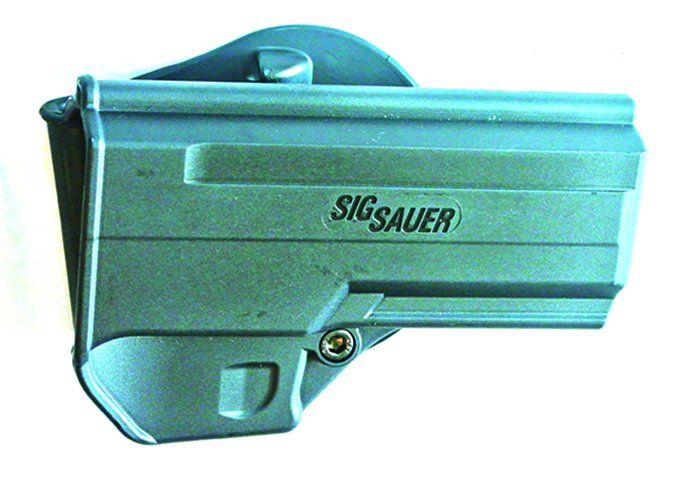
From this core, the user can change the grip frame size and color, slide assemblies, and even change to a limited number of chamberings. (The 9mm, 40 S&W, and 357 SIG calibers are interchangeable. The 45 ACP barrel assembly is not.) The grip options are reasonably priced at $47 from the SIG Store. Complete caliber conversion kits are a pricier at $400. This modular design brings the user a tremendous amount of ergonomic, economic, and operational flexibility. This can a very real advantage, in that the user can use different setups of the same firearm for recreational shooting, home defense, and concealed carry, while not having to adapt to different triggers and other controls.
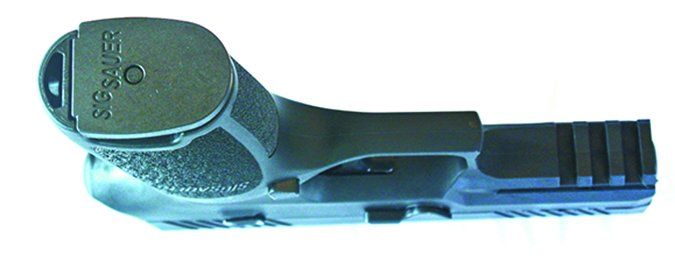
The P320 design breaks down for cleaning like most SIGs. Unlike some striker-fired pistols, the user does not have to pull the trigger to field-strip the gun. This lessens the possibility of a negligent discharge.
Our P320 was a very utilitarian, all-black piece with a very even Nitron finish that closely matched the color of the frame. The frame comes with a three-slot Picatinny rail on the dust cover. The tritium SIG-Lite three-dot sights were universally liked. The SIG P320’s design benefits from many years of industry refinements in ergonomics. Most of the testers liked the grip shape, size and stippled texture. The frame has finger indentations on both sides of the frame that make it easier to reach the trigger and magazine release. The triangular magazine release is nicely sized and reversible and ejected the magazines with vigor. The slide release is ambidextrous, which accommodates both left- and right-handed shooters and allows users with weaker hands to press both sides to release the slide. While the slide was a little loose, all the testers found the slide easy to rack.

The controls on this particular pistol benefited from a break-in period. The slide release was a little balky for the earlier testers, but our final tester found the slide could be released even with weaker hands. The two-stage trigger saw great improvements over time. In the beginning, the testers found the trigger to be well rounded in contour, but stiff and gritty.
By the end of testing, the trigger was much smoother and more consistent, with a very light first stage and a crisp final pull that seemed lighter than its weight of 8.1 pounds.
The testers found the P320 comfortable to shoot and it created only moderate recoil. One of the male testers found the grip a little loose in his hand, but the rest of the testers found the grip to be a good fit. One of the female shooters noted that the pistol was a natural pointer for her. The good sights, comfortable grip, and improved trigger may all have been factors in the excellent shooting results shown by the P320. This P320 was second fastest in the speed drills with an elapsed time of 3.48 seconds.
The P320 was the most accurate pistol in the test with all three choices of ammunition. The economy 124-grain Sellier & Bellot full-metal-jacket ammunition averaged 3.6-inch groups, with the largest group of 5.4 inches and the smallest group an excellent 1.9 inches. The 124-grain RMS FMJ averaged an even better 3.2 inches, with the largest group being 5.0 inches and the smallest group an amazing 1.0 inches. The Federal 115-grain JHP self-defense ammunition averaged an excellent 2.8 inches, with the largest at 3.2 inches and the smallest at 2.3 inches.
Our Team Said: Although it was the least expensive pistol in the test, the P320 proved to be the most accurate pistol of the five guns tested. It is also easily the most flexible and ergonomic design in this test. With the different options available, there is very little this pistol could not do within the limits of the cartridge. While all the pistols in this test are quality pistols and scored well, the SIG P320 is the surprise winner.
Written and photographed by David Tannahill, using evaluations from Gun Tests team testers.

























